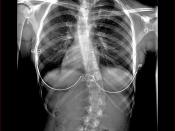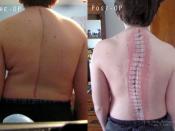DEREK IVY - COPING WITH SCOLIOSIS
Aitcheson, C. (1996). Guest Editorial: Ready to straighten up? This common condition
that contorts spine and self-image is correctable! Cosmopolitan, Feb., 116-120.
SUMMARY
Gracefully, the statuesque Southern belle walked toward the stage, each delicate
step bringing her closer to the moment she'd been dreading. After seven years as a
beauty-pageant contestant, she was facing her first swimsuit competition, about to
perform a 360-degree turn wearing only a one-piece bathing suit, heels, and a smile.
Although it was a significant portion of the competition, she executed the twirl a bit too
fast, because she didn't want the judges to scrutinize a scar that ran the entire length of
her spine, the result of an operation eleven years earlier to correct scoliosis. In the end,
neither her imperfect pivot nor flawed posterior seemed to matter: Michelle Mauney,
twenty-five, won the swimsuit competition and the title of Miss North Carolina U.S.A.
1995.
'I was scared and self-conscious until the instant the winner was announced,'
recalls Michelle. 'Walking around in a bathing suit in front of all those people was the
hardest thing I'd ever done, but it really boosted my confidence and made me feel normal
for the first time in my life!'
No one knows exactly what causes scoliosis, but since the disorder seems to run
in families, researchers have long suspected genetics play an important role. Less-
common causes include vertebral birth defects and neuromuscular diseases such as
cerebral palsy and spina bifida.
What is scoliosis? A chronic, progressive condition affecting approximately 2
percent of the population. Typically, it strikes girls between ages ten and fifteen, causing
their backbones to bow from side to side rather than grow in a straight line from neck to
tailbone. Although not life-threatening, if left untreated, a misshapen...


